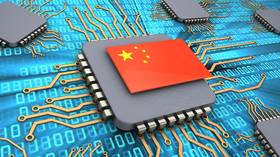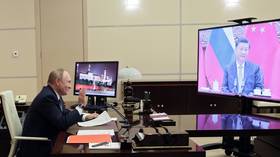The war-like measures US is taking to dominate world trade over China
Tom Fowdy
is a British writer and analyst of politics and international relations with a primary focus on East Asia.

After months of having vanished, and in line with a renewed frontloading of Xinjiang-related propaganda from Washington, the Uyghur Forced Labor Prevention Act resurfaced on Capitol Hill this week.
With the White House publicly voicing support for the bill, it passed the House of Representatives and is soon expected to clear the Senate. What does it entail? It bans outright the import of goods from China’s Xinjiang autonomous region on the presumption of a ‘guilty until proven innocent’ status that they were made with forced labor, unless a company can prove otherwise. Arnaud Bertrand, a China-based French commentator on Twitter, described it as one of the “most cynical pieces of US legislation ever.”
Its goal is not so much to seriously address concerns of ‘forced labor’ in the province, but to damage China’s grip over certain global supply chains. The White House statement itself could not make its intent clearer, by stating that it supports the goal of either “reshoring” or “third shoring” supply chains away from China that it considers strategic, listing semiconductors and renewable energy in particular. As the bill has been in the works, the US international development corporation has likewise been pursuing an $500 million solar panel production investment in India. These moves constitute a layered and coordinated strategy – to seek to contain China via means of a supply chain shift.
By 2021, though, it should be obvious that it is impossible to beat China head on in trade. Trump’s trade war did not yield serious results, and the tariffs he imposed have contributed to swelling inflation back home.
China’s supply, production, logistical, and manufacturing capabilities are unparalleled, meaning their products are more affordable than other countries’. Because it can’t compete with this, the US is left to play dirty by weaponizing allegations of human rights abuses and forced labor as a stick to attack China’s industries and legitimize sanctions. Xinjiang has become a means of ‘manufacturing consent’ among Washington’s allies, to buy support for its policies.
Xinjiang has been used to blacklist Chinese technology firms by implicating them in human rights abuses. Allegations of forced labor have been used to blacklist Chinese exports and supply chains which the US wants to contain. This has so far included cotton, tomatoes, and solar panels, the latter of which has been the primary target of the Biden administration.
The president wants to produce renewable energy products either at home or in friendly third countries, not China. From the beginning of the year, a series of coordinated studies emerged groundlessly accusing Beijing, which dominates the global production of panels, of engaging in forced labor to build them. There was no actual evidence put forward, but all that was needed to get the US’ job done was the insinuation to be put out.
Biden is also consolidating an anti-China semiconductor strategy. While not related to Xinjiang, it has two familiar goals – keeping China out of the global supply chain and consolidating manufacturing in other countries. The administration is looking at slapping even more restrictions on SMIC, China’s leading semiconductor manufacturer, to block its access to US tech. This goes alongside the blacklisting of all Chinese semiconductor firms and weaponizing US-held patents to stop Beijing from obtaining advanced equipment, as sold through a Dutch firm.
Alongside this, Washington has sought to block all Chinese takeovers of semiconductor firms around the world, as it did recently with Magnachip in South Korea. It’s also opposing all major semiconductor investments into China. It blocked a big Intel investment there, which has now gone to Malaysia, and is seeking to stop a proposed huge new factory by South Korea’s Hynix.
Washington is likewise strong-arming and coordinating big semiconductor firms to build capacity in allied countries. It has pressured Taiwan’s TSMC to build plants in Arizona, Japan, and Germany – India might be next – while making Samsung invest in a foundry in Texas.
How does China respond to this maneuvering? While the US steps will not destroy China’s solar panel industry or undermine its global competitiveness – and risk blowback costs for America – the semiconductor sector nonetheless remains Beijing’s biggest Achilles’ heel. It realizes it is behind the game, and is devoting hundreds of billions in investment to try to break through, but it is yielding only slow progress.
Beijing increasingly needs semiconductors for its own economic growth and development, and the Biden administration realizes this can be turned into a tool to squeeze them.
China should perhaps take a leaf out of Washington’s playbook, and contemplate responding to this attempt at ‘supply chain encirclement’ by investing in semiconductor capabilities in friendly countries. For example, the Putin-Xi summit concluded this week with pledges to enhance cooperation in the fields of strategic technologies. Why doesn’t SMIC or other Chinese manufacturers invest in a foundry in Russia? As well as other strategic countries of interest such as Pakistan?
Building up a semiconductor industry with allies is what Washington has always done to gain the upper hand. South Korea, Japan, and Taiwan, to name a few, built their industries and prospered precisely because the US gave them the technology and expertise to do so, backed by their export market.
It would, in turn, be a strategic counterweight if Beijing began building up a semiconductor supply chain across multiple countries, as opposed to just itself, which makes it easier to target. Likewise, China’s solar panel companies will also need to invest in overseas capacity to diversify away from the opportunistic Xinjiang stigma.
There is enough evidence today to map out a significant part of Biden’s game when it comes to China: Supply chain entrenchment, dominance, and encirclement – achieved by using human rights as a weapon, and exerting pressure on firms not to build capacity in China, while entrenching investments at home and in friendly countries.
This is Biden’s anti-China protectionism taking physical and tactical form, as opposed to the irrational browbeating of Trump. It is not without its risks, particularly in a country with skyrocketing inflation, but if America is successful, it could define the outcome of the competition with China. Beijing has to be smart and strategic in how it counters this, utilizing countries friendly to it, rather than going it alone.
The statements, views and opinions expressed in this column are solely those of the author and do not necessarily represent those of RT.




0 Comments:
Post a Comment
Subscribe to Post Comments [Atom]
<< Home